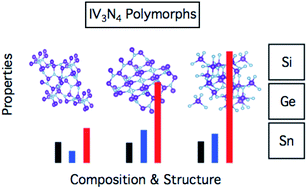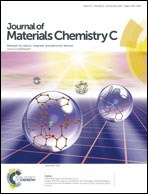Semiconducting properties of spinel tin nitride and other IV3N4 polymorphs†
Abstract
Tin nitride, Sn3N4, is a semiconductor composed of common elements with a band gap in the visible range, making it a candidate for optical and electronic applications. In this work, the semiconducting properties of tin nitride are explored by thin-film experiments and first-principles theory to evaluate the prospects of this material for optoelectronic applications. Calculations of related group IV nitride polymorphs provide additional insight into the properties and challenges associated with this class of semiconductors. Experimentally, in Sn3N4 polycrystalline thin films the electron concentration was found to be 1018 cm−3 with Hall mobility of ∼1 cm2 V−1 s−1 and a minority carrier (holes) diffusion length of 50–100 nm. The optical absorption onset was determined at 1.6 eV and an ionization potential was measured at 5.9–6.0 eV. From theory, a direct band gap of 1.54 eV was determined with weak dipole-forbidden lowest energy transitions and the ionization potential was determined to be 6.5 eV, both in reasonable agreement with the experiments. Calculations also predict an exceptionally small electron effective mass (0.18 m0) and a large hole effective mass (12.9 m0), which may be in part responsible for the short hole diffusion length. To elucidate the origin of the heavy holes in Sn3N4, elemental and crystallographic trends in electronic structure and thermochemical properties are calculated in the IV3N4 polymorphs. It was found that hole effective masses generally increase down the period and are structure-dependent, while electron effective masses decrease down the period and show no strong structural trends. These results suggest that changing composition in the group-IV nitride alloys will have a large impact on the fundamental semiconductor properties such as carrier effective masses, and provide other insight into the materials chemistry of Sn3N4 and the IV3N4 family.


 Please wait while we load your content...
Please wait while we load your content...